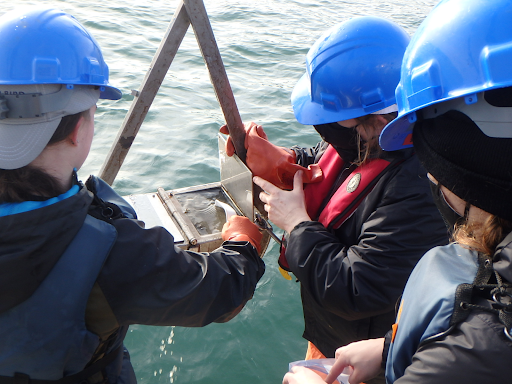
NCCOS-funded partners recently completed the second of a two-phased research cruise in Puget Sound as part of a coordinated, multi-region project to monitor harmful algal blooms (HABs). The work is helping establish a capacity for algal cyst enumeration that will enable researchers to identify where future Alexandrium catenella blooms may occur, advance HAB forecasting applications in Puget Sound and Alaska, and support improvements to NOAA Gulf of Maine HAB forecasts.
The University of Washington Tacoma (UWT) Greengrove lab team led efforts to grab samples of the top three centimeters of bottom sediment from several locations throughout Puget Sound. Earlier this month the team completed a four day cruise in Northern Puget Sound waters, sampling Bellingham Bay and Whidbey Island stations onboard the University of Washington Applied Physics Lab R\V Robertson. The second leg, another four day cruise, ended January 31 completing the sampling of known HAB hotspots in central Puget Sound.
After sediment samples are analyzed using microscopy methods, they will be added to earlier sampling results to improve maps of cyst abundance in the region. Puget Sound cyst abundance data will be combined with results from samples collected in December 2021 from Kodiak, Alaska, and from samples that NCCOS plans to collect during their annual Gulf of Maine cyst cruise planned for February 2022. This will mark the completion of a second full season of collecting cyst samples from these project regions. A full suite of samples was last collected in all three regions in 2020, however, scientists were only able to collect sediments from the Gulf of Maine and Kodiak, Alaska in 2021 due to COVID constraints.
Further UWT-NOAA project collaborations planned this year will complete analysis of all samples using standard microscopy, do an interlab comparison of the standard method, facilitate validation of the quantitative molecular method quantitative polymerase chain reaction (qPCR), complete development of a fluorescent in situ hybridization (FISH) method, take steps to integrate new methods into NOAA Gulf of Maine HAB forecasting, and prepare to share new procedures with stakeholders.
These efforts advance the primary objective of the project to develop and test new quantitative molecular methods that promise faster and less costly results than the current microscopy-based method. The research also promises to improve NOAA’s Gulf of Maine HAB forecast products and expand existing knowledge to mitigate risks from toxic Alexandrium blooms in Puget Sound and Alaska. The work is funded through NCCOS’s Monitoring and Event Response Harmful Algal Blooms (MERHAB) Program.
